Child Abuse and Neglect Research
VerifiedAdded on 2020/01/07
|11
|3449
|287
Essay
AI Summary
The assignment delves into the topic of child maltreatment and victimization in the UK. It requires students to analyze findings from a population survey involving caregivers, children, young people, and young adults. The focus is on understanding the prevalence and impact of various forms of abuse, including physical, sexual, and emotional, drawing upon relevant academic literature and research studies.
Contribute Materials
Your contribution can guide someone’s learning journey. Share your
documents today.
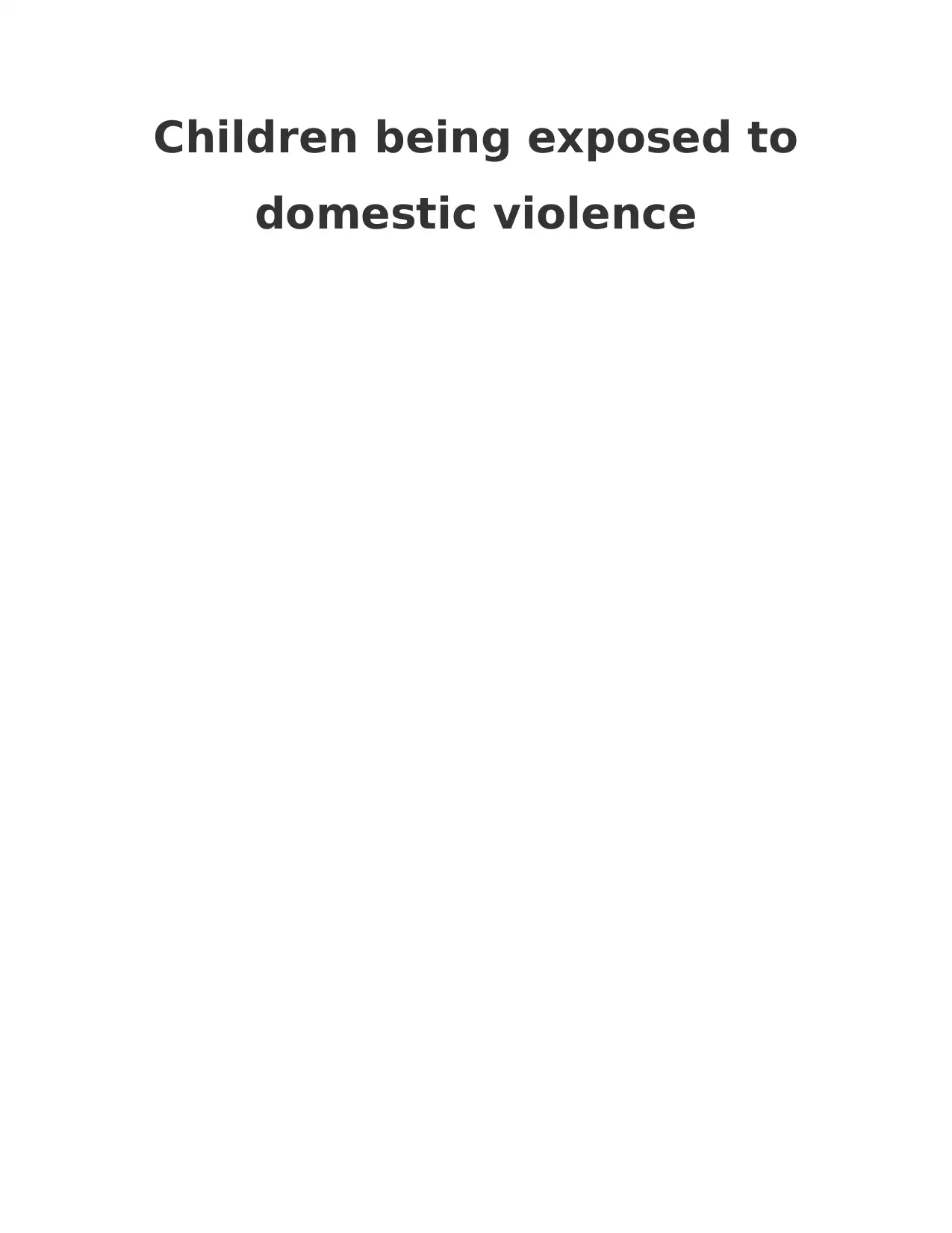
Children being exposed to
domestic violence
domestic violence
Secure Best Marks with AI Grader
Need help grading? Try our AI Grader for instant feedback on your assignments.
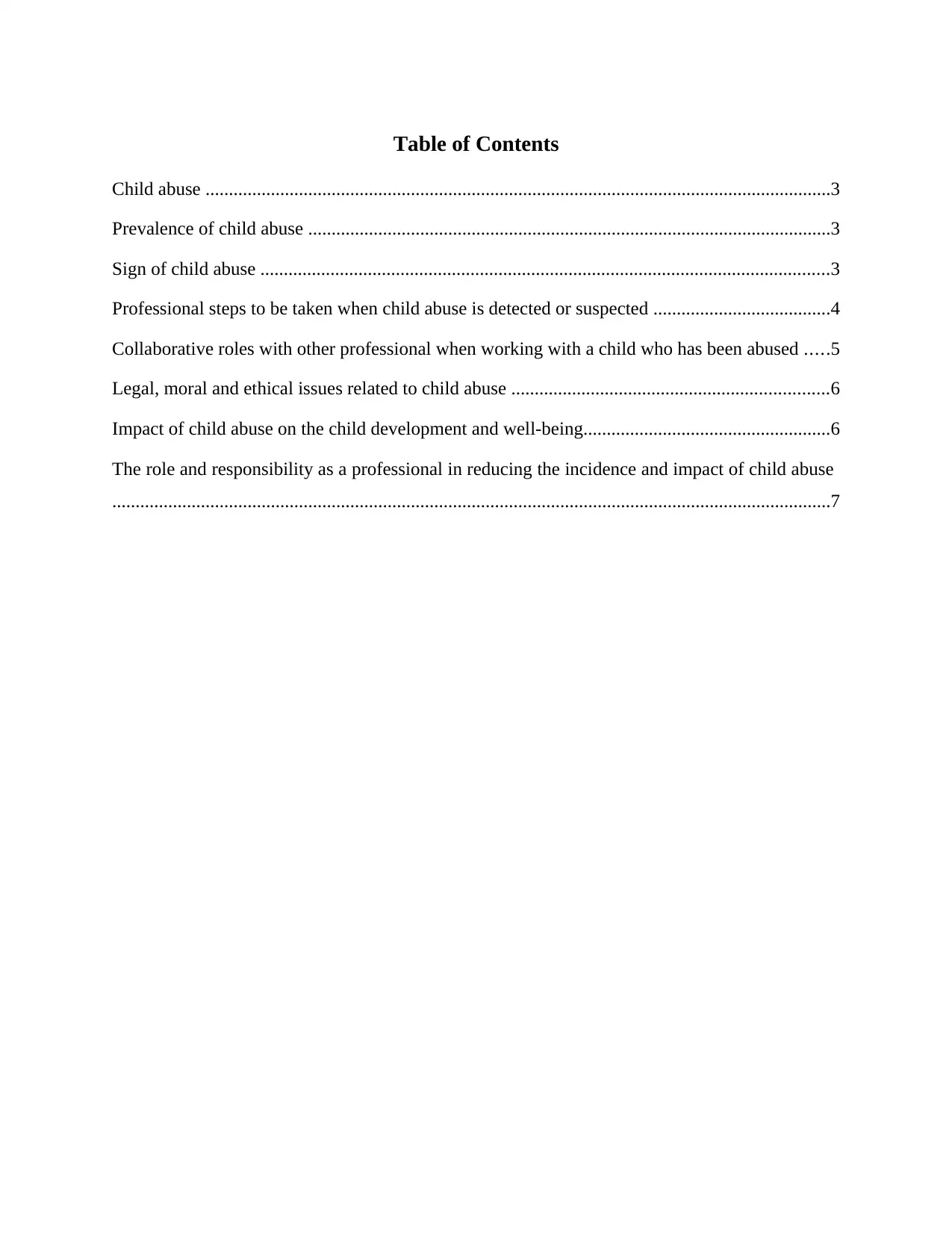
Table of Contents
Child abuse ......................................................................................................................................3
Prevalence of child abuse ................................................................................................................3
Sign of child abuse ..........................................................................................................................3
Professional steps to be taken when child abuse is detected or suspected ......................................4
Collaborative roles with other professional when working with a child who has been abused .....5
Legal, moral and ethical issues related to child abuse ....................................................................6
Impact of child abuse on the child development and well-being.....................................................6
The role and responsibility as a professional in reducing the incidence and impact of child abuse
..........................................................................................................................................................7
Child abuse ......................................................................................................................................3
Prevalence of child abuse ................................................................................................................3
Sign of child abuse ..........................................................................................................................3
Professional steps to be taken when child abuse is detected or suspected ......................................4
Collaborative roles with other professional when working with a child who has been abused .....5
Legal, moral and ethical issues related to child abuse ....................................................................6
Impact of child abuse on the child development and well-being.....................................................6
The role and responsibility as a professional in reducing the incidence and impact of child abuse
..........................................................................................................................................................7
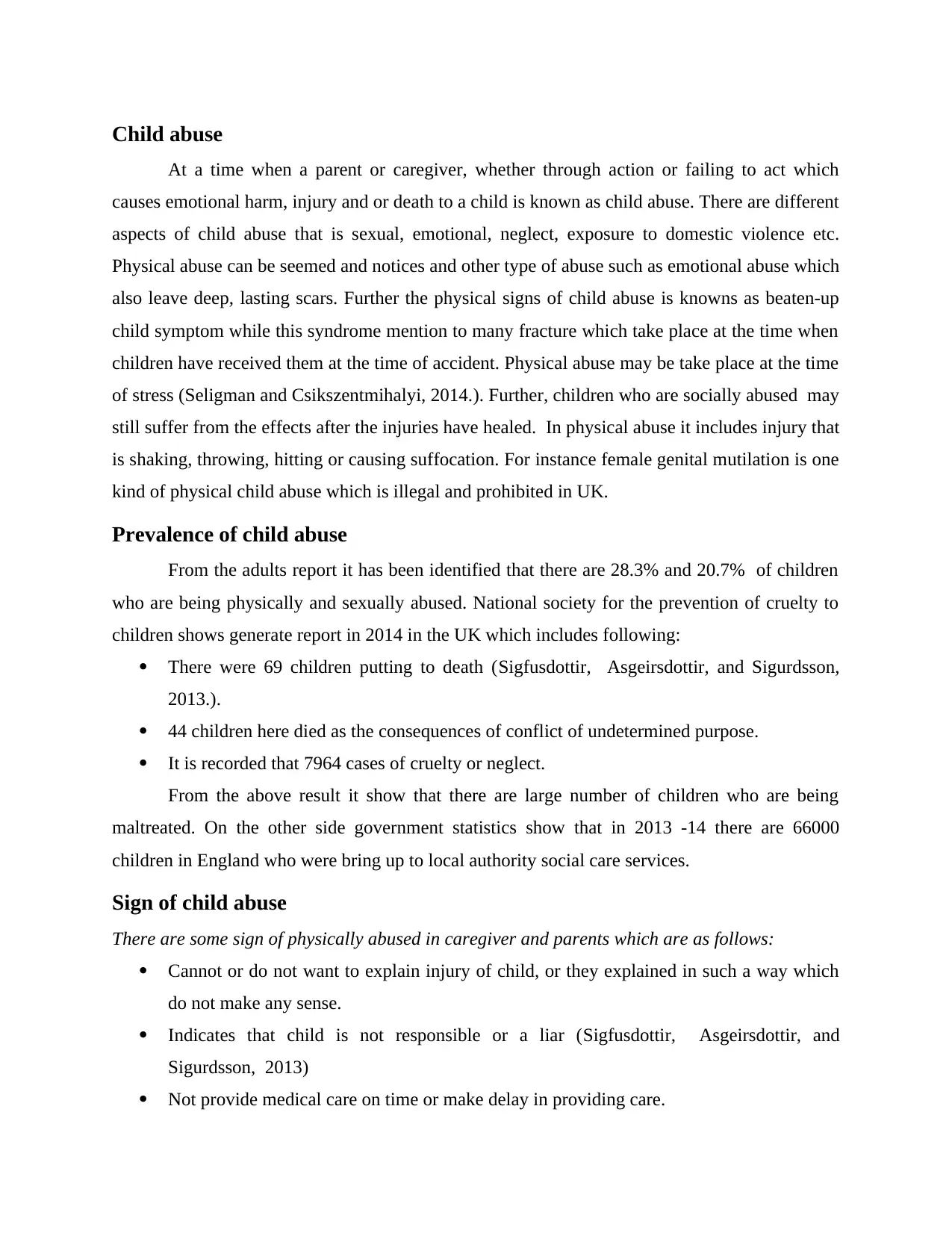
Child abuse
At a time when a parent or caregiver, whether through action or failing to act which
causes emotional harm, injury and or death to a child is known as child abuse. There are different
aspects of child abuse that is sexual, emotional, neglect, exposure to domestic violence etc.
Physical abuse can be seemed and notices and other type of abuse such as emotional abuse which
also leave deep, lasting scars. Further the physical signs of child abuse is knowns as beaten-up
child symptom while this syndrome mention to many fracture which take place at the time when
children have received them at the time of accident. Physical abuse may be take place at the time
of stress (Seligman and Csikszentmihalyi, 2014.). Further, children who are socially abused may
still suffer from the effects after the injuries have healed. In physical abuse it includes injury that
is shaking, throwing, hitting or causing suffocation. For instance female genital mutilation is one
kind of physical child abuse which is illegal and prohibited in UK.
Prevalence of child abuse
From the adults report it has been identified that there are 28.3% and 20.7% of children
who are being physically and sexually abused. National society for the prevention of cruelty to
children shows generate report in 2014 in the UK which includes following:
There were 69 children putting to death (Sigfusdottir, Asgeirsdottir, and Sigurdsson,
2013.).
44 children here died as the consequences of conflict of undetermined purpose.
It is recorded that 7964 cases of cruelty or neglect.
From the above result it show that there are large number of children who are being
maltreated. On the other side government statistics show that in 2013 -14 there are 66000
children in England who were bring up to local authority social care services.
Sign of child abuse
There are some sign of physically abused in caregiver and parents which are as follows:
Cannot or do not want to explain injury of child, or they explained in such a way which
do not make any sense.
Indicates that child is not responsible or a liar (Sigfusdottir, Asgeirsdottir, and
Sigurdsson, 2013)
Not provide medical care on time or make delay in providing care.
At a time when a parent or caregiver, whether through action or failing to act which
causes emotional harm, injury and or death to a child is known as child abuse. There are different
aspects of child abuse that is sexual, emotional, neglect, exposure to domestic violence etc.
Physical abuse can be seemed and notices and other type of abuse such as emotional abuse which
also leave deep, lasting scars. Further the physical signs of child abuse is knowns as beaten-up
child symptom while this syndrome mention to many fracture which take place at the time when
children have received them at the time of accident. Physical abuse may be take place at the time
of stress (Seligman and Csikszentmihalyi, 2014.). Further, children who are socially abused may
still suffer from the effects after the injuries have healed. In physical abuse it includes injury that
is shaking, throwing, hitting or causing suffocation. For instance female genital mutilation is one
kind of physical child abuse which is illegal and prohibited in UK.
Prevalence of child abuse
From the adults report it has been identified that there are 28.3% and 20.7% of children
who are being physically and sexually abused. National society for the prevention of cruelty to
children shows generate report in 2014 in the UK which includes following:
There were 69 children putting to death (Sigfusdottir, Asgeirsdottir, and Sigurdsson,
2013.).
44 children here died as the consequences of conflict of undetermined purpose.
It is recorded that 7964 cases of cruelty or neglect.
From the above result it show that there are large number of children who are being
maltreated. On the other side government statistics show that in 2013 -14 there are 66000
children in England who were bring up to local authority social care services.
Sign of child abuse
There are some sign of physically abused in caregiver and parents which are as follows:
Cannot or do not want to explain injury of child, or they explained in such a way which
do not make any sense.
Indicates that child is not responsible or a liar (Sigfusdottir, Asgeirsdottir, and
Sigurdsson, 2013)
Not provide medical care on time or make delay in providing care.
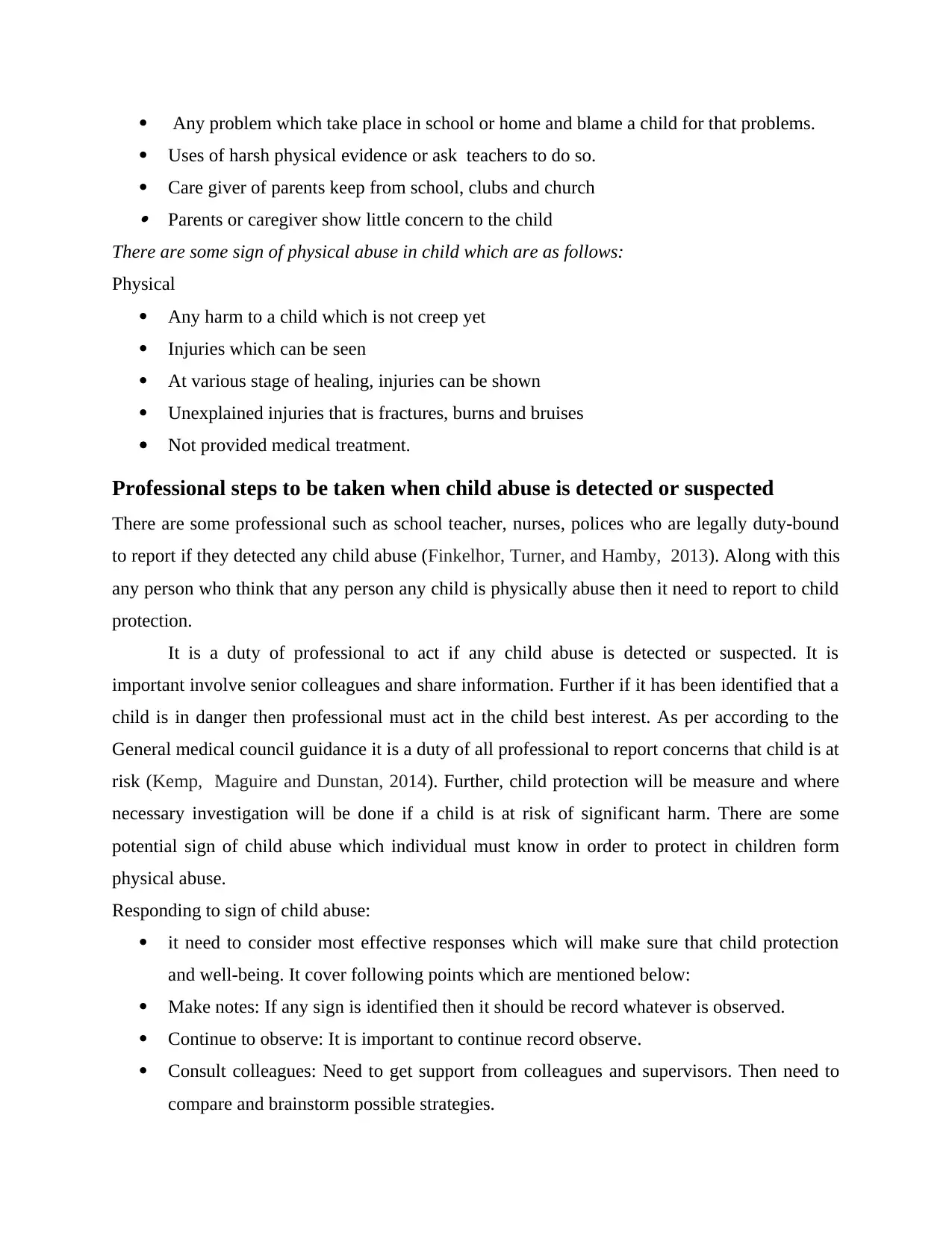
Any problem which take place in school or home and blame a child for that problems.
Uses of harsh physical evidence or ask teachers to do so.
Care giver of parents keep from school, clubs and church Parents or caregiver show little concern to the child
There are some sign of physical abuse in child which are as follows:
Physical
Any harm to a child which is not creep yet
Injuries which can be seen
At various stage of healing, injuries can be shown
Unexplained injuries that is fractures, burns and bruises
Not provided medical treatment.
Professional steps to be taken when child abuse is detected or suspected
There are some professional such as school teacher, nurses, polices who are legally duty-bound
to report if they detected any child abuse (Finkelhor, Turner, and Hamby, 2013). Along with this
any person who think that any person any child is physically abuse then it need to report to child
protection.
It is a duty of professional to act if any child abuse is detected or suspected. It is
important involve senior colleagues and share information. Further if it has been identified that a
child is in danger then professional must act in the child best interest. As per according to the
General medical council guidance it is a duty of all professional to report concerns that child is at
risk (Kemp, Maguire and Dunstan, 2014). Further, child protection will be measure and where
necessary investigation will be done if a child is at risk of significant harm. There are some
potential sign of child abuse which individual must know in order to protect in children form
physical abuse.
Responding to sign of child abuse:
it need to consider most effective responses which will make sure that child protection
and well-being. It cover following points which are mentioned below:
Make notes: If any sign is identified then it should be record whatever is observed.
Continue to observe: It is important to continue record observe.
Consult colleagues: Need to get support from colleagues and supervisors. Then need to
compare and brainstorm possible strategies.
Uses of harsh physical evidence or ask teachers to do so.
Care giver of parents keep from school, clubs and church Parents or caregiver show little concern to the child
There are some sign of physical abuse in child which are as follows:
Physical
Any harm to a child which is not creep yet
Injuries which can be seen
At various stage of healing, injuries can be shown
Unexplained injuries that is fractures, burns and bruises
Not provided medical treatment.
Professional steps to be taken when child abuse is detected or suspected
There are some professional such as school teacher, nurses, polices who are legally duty-bound
to report if they detected any child abuse (Finkelhor, Turner, and Hamby, 2013). Along with this
any person who think that any person any child is physically abuse then it need to report to child
protection.
It is a duty of professional to act if any child abuse is detected or suspected. It is
important involve senior colleagues and share information. Further if it has been identified that a
child is in danger then professional must act in the child best interest. As per according to the
General medical council guidance it is a duty of all professional to report concerns that child is at
risk (Kemp, Maguire and Dunstan, 2014). Further, child protection will be measure and where
necessary investigation will be done if a child is at risk of significant harm. There are some
potential sign of child abuse which individual must know in order to protect in children form
physical abuse.
Responding to sign of child abuse:
it need to consider most effective responses which will make sure that child protection
and well-being. It cover following points which are mentioned below:
Make notes: If any sign is identified then it should be record whatever is observed.
Continue to observe: It is important to continue record observe.
Consult colleagues: Need to get support from colleagues and supervisors. Then need to
compare and brainstorm possible strategies.
Secure Best Marks with AI Grader
Need help grading? Try our AI Grader for instant feedback on your assignments.
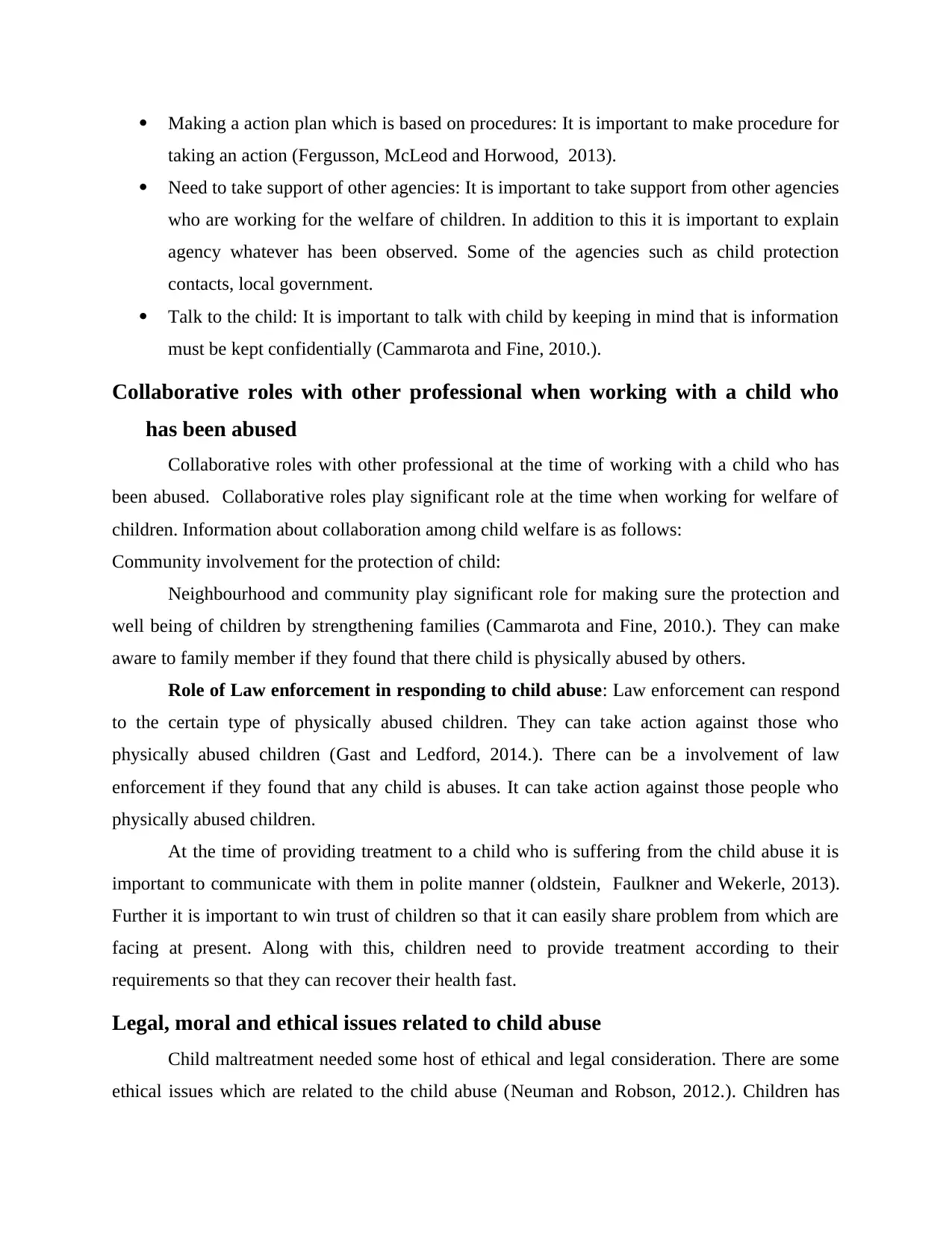
Making a action plan which is based on procedures: It is important to make procedure for
taking an action (Fergusson, McLeod and Horwood, 2013).
Need to take support of other agencies: It is important to take support from other agencies
who are working for the welfare of children. In addition to this it is important to explain
agency whatever has been observed. Some of the agencies such as child protection
contacts, local government.
Talk to the child: It is important to talk with child by keeping in mind that is information
must be kept confidentially (Cammarota and Fine, 2010.).
Collaborative roles with other professional when working with a child who
has been abused
Collaborative roles with other professional at the time of working with a child who has
been abused. Collaborative roles play significant role at the time when working for welfare of
children. Information about collaboration among child welfare is as follows:
Community involvement for the protection of child:
Neighbourhood and community play significant role for making sure the protection and
well being of children by strengthening families (Cammarota and Fine, 2010.). They can make
aware to family member if they found that there child is physically abused by others.
Role of Law enforcement in responding to child abuse: Law enforcement can respond
to the certain type of physically abused children. They can take action against those who
physically abused children (Gast and Ledford, 2014.). There can be a involvement of law
enforcement if they found that any child is abuses. It can take action against those people who
physically abused children.
At the time of providing treatment to a child who is suffering from the child abuse it is
important to communicate with them in polite manner (oldstein, Faulkner and Wekerle, 2013).
Further it is important to win trust of children so that it can easily share problem from which are
facing at present. Along with this, children need to provide treatment according to their
requirements so that they can recover their health fast.
Legal, moral and ethical issues related to child abuse
Child maltreatment needed some host of ethical and legal consideration. There are some
ethical issues which are related to the child abuse (Neuman and Robson, 2012.). Children has
taking an action (Fergusson, McLeod and Horwood, 2013).
Need to take support of other agencies: It is important to take support from other agencies
who are working for the welfare of children. In addition to this it is important to explain
agency whatever has been observed. Some of the agencies such as child protection
contacts, local government.
Talk to the child: It is important to talk with child by keeping in mind that is information
must be kept confidentially (Cammarota and Fine, 2010.).
Collaborative roles with other professional when working with a child who
has been abused
Collaborative roles with other professional at the time of working with a child who has
been abused. Collaborative roles play significant role at the time when working for welfare of
children. Information about collaboration among child welfare is as follows:
Community involvement for the protection of child:
Neighbourhood and community play significant role for making sure the protection and
well being of children by strengthening families (Cammarota and Fine, 2010.). They can make
aware to family member if they found that there child is physically abused by others.
Role of Law enforcement in responding to child abuse: Law enforcement can respond
to the certain type of physically abused children. They can take action against those who
physically abused children (Gast and Ledford, 2014.). There can be a involvement of law
enforcement if they found that any child is abuses. It can take action against those people who
physically abused children.
At the time of providing treatment to a child who is suffering from the child abuse it is
important to communicate with them in polite manner (oldstein, Faulkner and Wekerle, 2013).
Further it is important to win trust of children so that it can easily share problem from which are
facing at present. Along with this, children need to provide treatment according to their
requirements so that they can recover their health fast.
Legal, moral and ethical issues related to child abuse
Child maltreatment needed some host of ethical and legal consideration. There are some
ethical issues which are related to the child abuse (Neuman and Robson, 2012.). Children has
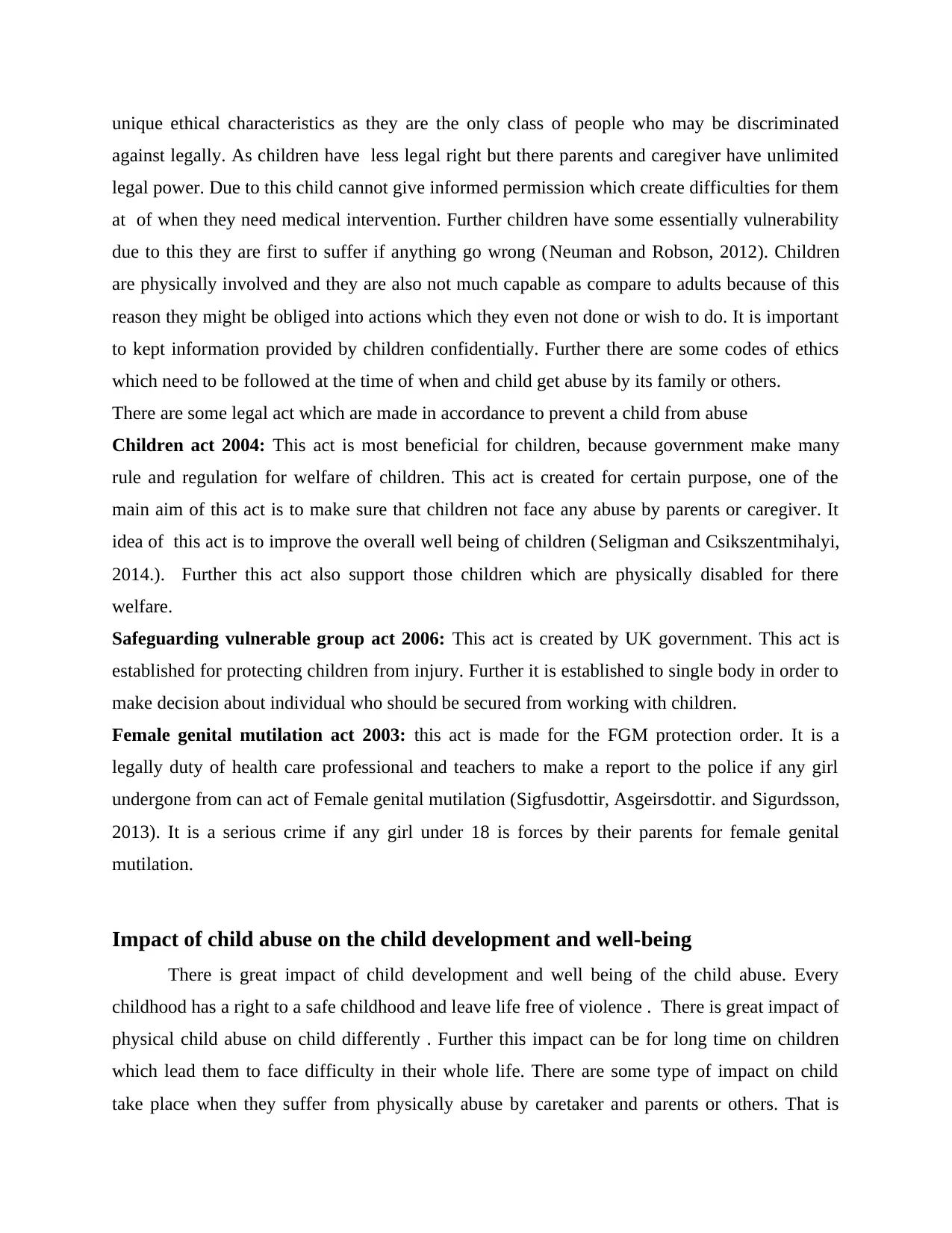
unique ethical characteristics as they are the only class of people who may be discriminated
against legally. As children have less legal right but there parents and caregiver have unlimited
legal power. Due to this child cannot give informed permission which create difficulties for them
at of when they need medical intervention. Further children have some essentially vulnerability
due to this they are first to suffer if anything go wrong (Neuman and Robson, 2012). Children
are physically involved and they are also not much capable as compare to adults because of this
reason they might be obliged into actions which they even not done or wish to do. It is important
to kept information provided by children confidentially. Further there are some codes of ethics
which need to be followed at the time of when and child get abuse by its family or others.
There are some legal act which are made in accordance to prevent a child from abuse
Children act 2004: This act is most beneficial for children, because government make many
rule and regulation for welfare of children. This act is created for certain purpose, one of the
main aim of this act is to make sure that children not face any abuse by parents or caregiver. It
idea of this act is to improve the overall well being of children (Seligman and Csikszentmihalyi,
2014.). Further this act also support those children which are physically disabled for there
welfare.
Safeguarding vulnerable group act 2006: This act is created by UK government. This act is
established for protecting children from injury. Further it is established to single body in order to
make decision about individual who should be secured from working with children.
Female genital mutilation act 2003: this act is made for the FGM protection order. It is a
legally duty of health care professional and teachers to make a report to the police if any girl
undergone from can act of Female genital mutilation (Sigfusdottir, Asgeirsdottir. and Sigurdsson,
2013). It is a serious crime if any girl under 18 is forces by their parents for female genital
mutilation.
Impact of child abuse on the child development and well-being
There is great impact of child development and well being of the child abuse. Every
childhood has a right to a safe childhood and leave life free of violence . There is great impact of
physical child abuse on child differently . Further this impact can be for long time on children
which lead them to face difficulty in their whole life. There are some type of impact on child
take place when they suffer from physically abuse by caretaker and parents or others. That is
against legally. As children have less legal right but there parents and caregiver have unlimited
legal power. Due to this child cannot give informed permission which create difficulties for them
at of when they need medical intervention. Further children have some essentially vulnerability
due to this they are first to suffer if anything go wrong (Neuman and Robson, 2012). Children
are physically involved and they are also not much capable as compare to adults because of this
reason they might be obliged into actions which they even not done or wish to do. It is important
to kept information provided by children confidentially. Further there are some codes of ethics
which need to be followed at the time of when and child get abuse by its family or others.
There are some legal act which are made in accordance to prevent a child from abuse
Children act 2004: This act is most beneficial for children, because government make many
rule and regulation for welfare of children. This act is created for certain purpose, one of the
main aim of this act is to make sure that children not face any abuse by parents or caregiver. It
idea of this act is to improve the overall well being of children (Seligman and Csikszentmihalyi,
2014.). Further this act also support those children which are physically disabled for there
welfare.
Safeguarding vulnerable group act 2006: This act is created by UK government. This act is
established for protecting children from injury. Further it is established to single body in order to
make decision about individual who should be secured from working with children.
Female genital mutilation act 2003: this act is made for the FGM protection order. It is a
legally duty of health care professional and teachers to make a report to the police if any girl
undergone from can act of Female genital mutilation (Sigfusdottir, Asgeirsdottir. and Sigurdsson,
2013). It is a serious crime if any girl under 18 is forces by their parents for female genital
mutilation.
Impact of child abuse on the child development and well-being
There is great impact of child development and well being of the child abuse. Every
childhood has a right to a safe childhood and leave life free of violence . There is great impact of
physical child abuse on child differently . Further this impact can be for long time on children
which lead them to face difficulty in their whole life. There are some type of impact on child
take place when they suffer from physically abuse by caretaker and parents or others. That is
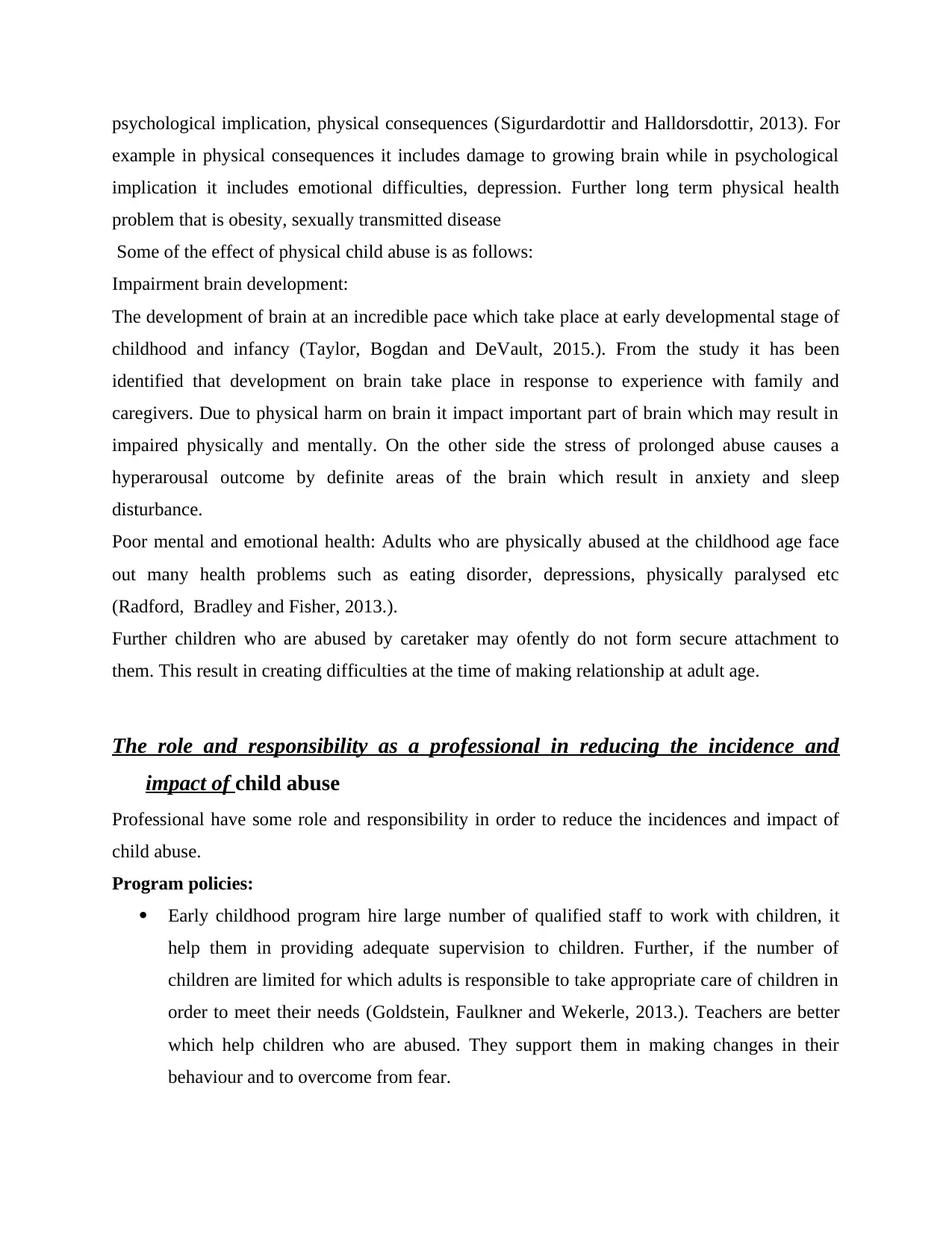
psychological implication, physical consequences (Sigurdardottir and Halldorsdottir, 2013). For
example in physical consequences it includes damage to growing brain while in psychological
implication it includes emotional difficulties, depression. Further long term physical health
problem that is obesity, sexually transmitted disease
Some of the effect of physical child abuse is as follows:
Impairment brain development:
The development of brain at an incredible pace which take place at early developmental stage of
childhood and infancy (Taylor, Bogdan and DeVault, 2015.). From the study it has been
identified that development on brain take place in response to experience with family and
caregivers. Due to physical harm on brain it impact important part of brain which may result in
impaired physically and mentally. On the other side the stress of prolonged abuse causes a
hyperarousal outcome by definite areas of the brain which result in anxiety and sleep
disturbance.
Poor mental and emotional health: Adults who are physically abused at the childhood age face
out many health problems such as eating disorder, depressions, physically paralysed etc
(Radford, Bradley and Fisher, 2013.).
Further children who are abused by caretaker may ofently do not form secure attachment to
them. This result in creating difficulties at the time of making relationship at adult age.
The role and responsibility as a professional in reducing the incidence and
impact of child abuse
Professional have some role and responsibility in order to reduce the incidences and impact of
child abuse.
Program policies:
Early childhood program hire large number of qualified staff to work with children, it
help them in providing adequate supervision to children. Further, if the number of
children are limited for which adults is responsible to take appropriate care of children in
order to meet their needs (Goldstein, Faulkner and Wekerle, 2013.). Teachers are better
which help children who are abused. They support them in making changes in their
behaviour and to overcome from fear.
example in physical consequences it includes damage to growing brain while in psychological
implication it includes emotional difficulties, depression. Further long term physical health
problem that is obesity, sexually transmitted disease
Some of the effect of physical child abuse is as follows:
Impairment brain development:
The development of brain at an incredible pace which take place at early developmental stage of
childhood and infancy (Taylor, Bogdan and DeVault, 2015.). From the study it has been
identified that development on brain take place in response to experience with family and
caregivers. Due to physical harm on brain it impact important part of brain which may result in
impaired physically and mentally. On the other side the stress of prolonged abuse causes a
hyperarousal outcome by definite areas of the brain which result in anxiety and sleep
disturbance.
Poor mental and emotional health: Adults who are physically abused at the childhood age face
out many health problems such as eating disorder, depressions, physically paralysed etc
(Radford, Bradley and Fisher, 2013.).
Further children who are abused by caretaker may ofently do not form secure attachment to
them. This result in creating difficulties at the time of making relationship at adult age.
The role and responsibility as a professional in reducing the incidence and
impact of child abuse
Professional have some role and responsibility in order to reduce the incidences and impact of
child abuse.
Program policies:
Early childhood program hire large number of qualified staff to work with children, it
help them in providing adequate supervision to children. Further, if the number of
children are limited for which adults is responsible to take appropriate care of children in
order to meet their needs (Goldstein, Faulkner and Wekerle, 2013.). Teachers are better
which help children who are abused. They support them in making changes in their
behaviour and to overcome from fear.
Paraphrase This Document
Need a fresh take? Get an instant paraphrase of this document with our AI Paraphraser
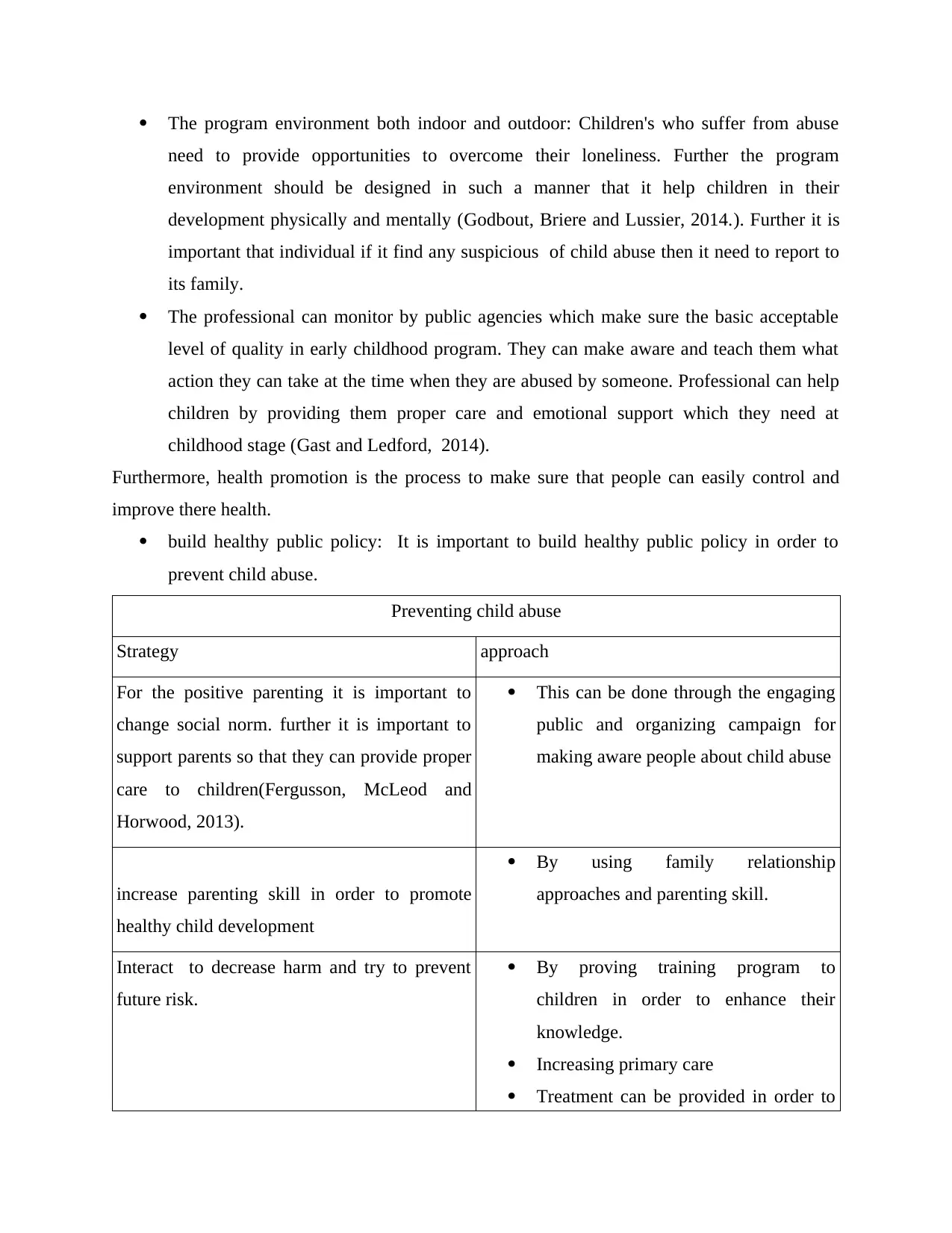
The program environment both indoor and outdoor: Children's who suffer from abuse
need to provide opportunities to overcome their loneliness. Further the program
environment should be designed in such a manner that it help children in their
development physically and mentally (Godbout, Briere and Lussier, 2014.). Further it is
important that individual if it find any suspicious of child abuse then it need to report to
its family.
The professional can monitor by public agencies which make sure the basic acceptable
level of quality in early childhood program. They can make aware and teach them what
action they can take at the time when they are abused by someone. Professional can help
children by providing them proper care and emotional support which they need at
childhood stage (Gast and Ledford, 2014).
Furthermore, health promotion is the process to make sure that people can easily control and
improve there health.
build healthy public policy: It is important to build healthy public policy in order to
prevent child abuse.
Preventing child abuse
Strategy approach
For the positive parenting it is important to
change social norm. further it is important to
support parents so that they can provide proper
care to children(Fergusson, McLeod and
Horwood, 2013).
This can be done through the engaging
public and organizing campaign for
making aware people about child abuse
increase parenting skill in order to promote
healthy child development
By using family relationship
approaches and parenting skill.
Interact to decrease harm and try to prevent
future risk.
By proving training program to
children in order to enhance their
knowledge.
Increasing primary care
Treatment can be provided in order to
need to provide opportunities to overcome their loneliness. Further the program
environment should be designed in such a manner that it help children in their
development physically and mentally (Godbout, Briere and Lussier, 2014.). Further it is
important that individual if it find any suspicious of child abuse then it need to report to
its family.
The professional can monitor by public agencies which make sure the basic acceptable
level of quality in early childhood program. They can make aware and teach them what
action they can take at the time when they are abused by someone. Professional can help
children by providing them proper care and emotional support which they need at
childhood stage (Gast and Ledford, 2014).
Furthermore, health promotion is the process to make sure that people can easily control and
improve there health.
build healthy public policy: It is important to build healthy public policy in order to
prevent child abuse.
Preventing child abuse
Strategy approach
For the positive parenting it is important to
change social norm. further it is important to
support parents so that they can provide proper
care to children(Fergusson, McLeod and
Horwood, 2013).
This can be done through the engaging
public and organizing campaign for
making aware people about child abuse
increase parenting skill in order to promote
healthy child development
By using family relationship
approaches and parenting skill.
Interact to decrease harm and try to prevent
future risk.
By proving training program to
children in order to enhance their
knowledge.
Increasing primary care
Treatment can be provided in order to
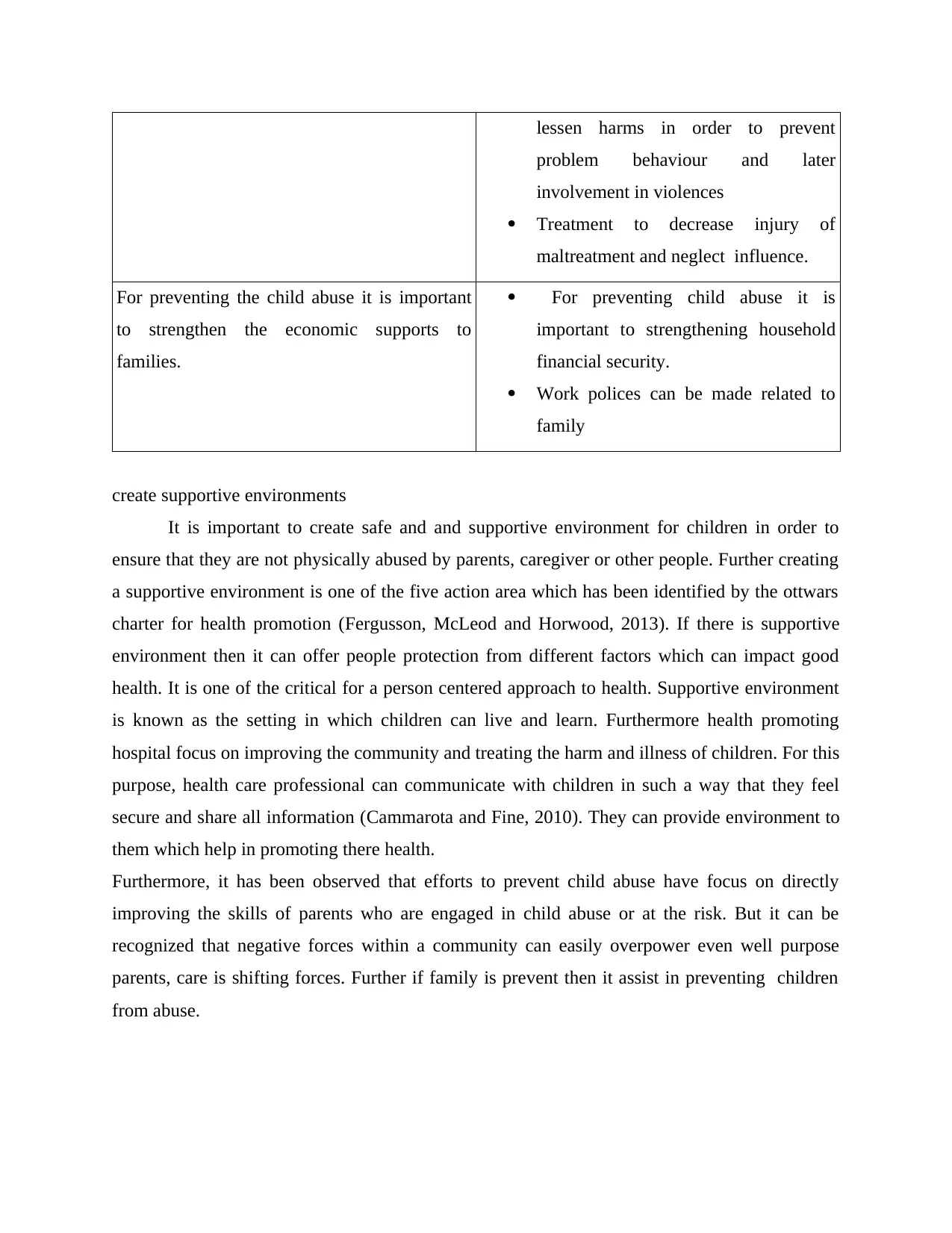
lessen harms in order to prevent
problem behaviour and later
involvement in violences
Treatment to decrease injury of
maltreatment and neglect influence.
For preventing the child abuse it is important
to strengthen the economic supports to
families.
For preventing child abuse it is
important to strengthening household
financial security.
Work polices can be made related to
family
create supportive environments
It is important to create safe and and supportive environment for children in order to
ensure that they are not physically abused by parents, caregiver or other people. Further creating
a supportive environment is one of the five action area which has been identified by the ottwars
charter for health promotion (Fergusson, McLeod and Horwood, 2013). If there is supportive
environment then it can offer people protection from different factors which can impact good
health. It is one of the critical for a person centered approach to health. Supportive environment
is known as the setting in which children can live and learn. Furthermore health promoting
hospital focus on improving the community and treating the harm and illness of children. For this
purpose, health care professional can communicate with children in such a way that they feel
secure and share all information (Cammarota and Fine, 2010). They can provide environment to
them which help in promoting there health.
Furthermore, it has been observed that efforts to prevent child abuse have focus on directly
improving the skills of parents who are engaged in child abuse or at the risk. But it can be
recognized that negative forces within a community can easily overpower even well purpose
parents, care is shifting forces. Further if family is prevent then it assist in preventing children
from abuse.
problem behaviour and later
involvement in violences
Treatment to decrease injury of
maltreatment and neglect influence.
For preventing the child abuse it is important
to strengthen the economic supports to
families.
For preventing child abuse it is
important to strengthening household
financial security.
Work polices can be made related to
family
create supportive environments
It is important to create safe and and supportive environment for children in order to
ensure that they are not physically abused by parents, caregiver or other people. Further creating
a supportive environment is one of the five action area which has been identified by the ottwars
charter for health promotion (Fergusson, McLeod and Horwood, 2013). If there is supportive
environment then it can offer people protection from different factors which can impact good
health. It is one of the critical for a person centered approach to health. Supportive environment
is known as the setting in which children can live and learn. Furthermore health promoting
hospital focus on improving the community and treating the harm and illness of children. For this
purpose, health care professional can communicate with children in such a way that they feel
secure and share all information (Cammarota and Fine, 2010). They can provide environment to
them which help in promoting there health.
Furthermore, it has been observed that efforts to prevent child abuse have focus on directly
improving the skills of parents who are engaged in child abuse or at the risk. But it can be
recognized that negative forces within a community can easily overpower even well purpose
parents, care is shifting forces. Further if family is prevent then it assist in preventing children
from abuse.
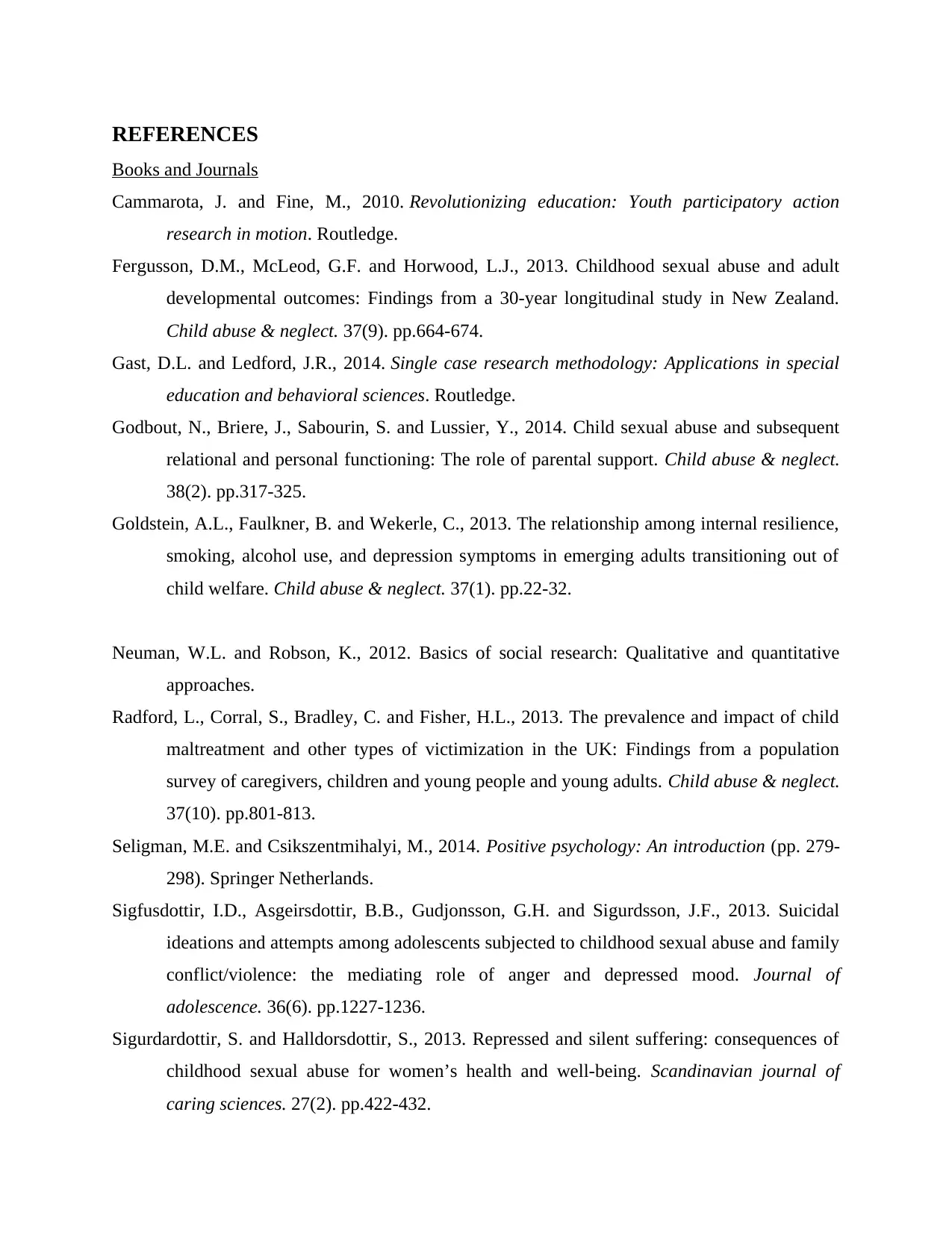
REFERENCES
Books and Journals
Cammarota, J. and Fine, M., 2010. Revolutionizing education: Youth participatory action
research in motion. Routledge.
Fergusson, D.M., McLeod, G.F. and Horwood, L.J., 2013. Childhood sexual abuse and adult
developmental outcomes: Findings from a 30-year longitudinal study in New Zealand.
Child abuse & neglect. 37(9). pp.664-674.
Gast, D.L. and Ledford, J.R., 2014. Single case research methodology: Applications in special
education and behavioral sciences. Routledge.
Godbout, N., Briere, J., Sabourin, S. and Lussier, Y., 2014. Child sexual abuse and subsequent
relational and personal functioning: The role of parental support. Child abuse & neglect.
38(2). pp.317-325.
Goldstein, A.L., Faulkner, B. and Wekerle, C., 2013. The relationship among internal resilience,
smoking, alcohol use, and depression symptoms in emerging adults transitioning out of
child welfare. Child abuse & neglect. 37(1). pp.22-32.
Neuman, W.L. and Robson, K., 2012. Basics of social research: Qualitative and quantitative
approaches.
Radford, L., Corral, S., Bradley, C. and Fisher, H.L., 2013. The prevalence and impact of child
maltreatment and other types of victimization in the UK: Findings from a population
survey of caregivers, children and young people and young adults. Child abuse & neglect.
37(10). pp.801-813.
Seligman, M.E. and Csikszentmihalyi, M., 2014. Positive psychology: An introduction (pp. 279-
298). Springer Netherlands.
Sigfusdottir, I.D., Asgeirsdottir, B.B., Gudjonsson, G.H. and Sigurdsson, J.F., 2013. Suicidal
ideations and attempts among adolescents subjected to childhood sexual abuse and family
conflict/violence: the mediating role of anger and depressed mood. Journal of
adolescence. 36(6). pp.1227-1236.
Sigurdardottir, S. and Halldorsdottir, S., 2013. Repressed and silent suffering: consequences of
childhood sexual abuse for women’s health and well‐being. Scandinavian journal of
caring sciences. 27(2). pp.422-432.
Books and Journals
Cammarota, J. and Fine, M., 2010. Revolutionizing education: Youth participatory action
research in motion. Routledge.
Fergusson, D.M., McLeod, G.F. and Horwood, L.J., 2013. Childhood sexual abuse and adult
developmental outcomes: Findings from a 30-year longitudinal study in New Zealand.
Child abuse & neglect. 37(9). pp.664-674.
Gast, D.L. and Ledford, J.R., 2014. Single case research methodology: Applications in special
education and behavioral sciences. Routledge.
Godbout, N., Briere, J., Sabourin, S. and Lussier, Y., 2014. Child sexual abuse and subsequent
relational and personal functioning: The role of parental support. Child abuse & neglect.
38(2). pp.317-325.
Goldstein, A.L., Faulkner, B. and Wekerle, C., 2013. The relationship among internal resilience,
smoking, alcohol use, and depression symptoms in emerging adults transitioning out of
child welfare. Child abuse & neglect. 37(1). pp.22-32.
Neuman, W.L. and Robson, K., 2012. Basics of social research: Qualitative and quantitative
approaches.
Radford, L., Corral, S., Bradley, C. and Fisher, H.L., 2013. The prevalence and impact of child
maltreatment and other types of victimization in the UK: Findings from a population
survey of caregivers, children and young people and young adults. Child abuse & neglect.
37(10). pp.801-813.
Seligman, M.E. and Csikszentmihalyi, M., 2014. Positive psychology: An introduction (pp. 279-
298). Springer Netherlands.
Sigfusdottir, I.D., Asgeirsdottir, B.B., Gudjonsson, G.H. and Sigurdsson, J.F., 2013. Suicidal
ideations and attempts among adolescents subjected to childhood sexual abuse and family
conflict/violence: the mediating role of anger and depressed mood. Journal of
adolescence. 36(6). pp.1227-1236.
Sigurdardottir, S. and Halldorsdottir, S., 2013. Repressed and silent suffering: consequences of
childhood sexual abuse for women’s health and well‐being. Scandinavian journal of
caring sciences. 27(2). pp.422-432.
Secure Best Marks with AI Grader
Need help grading? Try our AI Grader for instant feedback on your assignments.
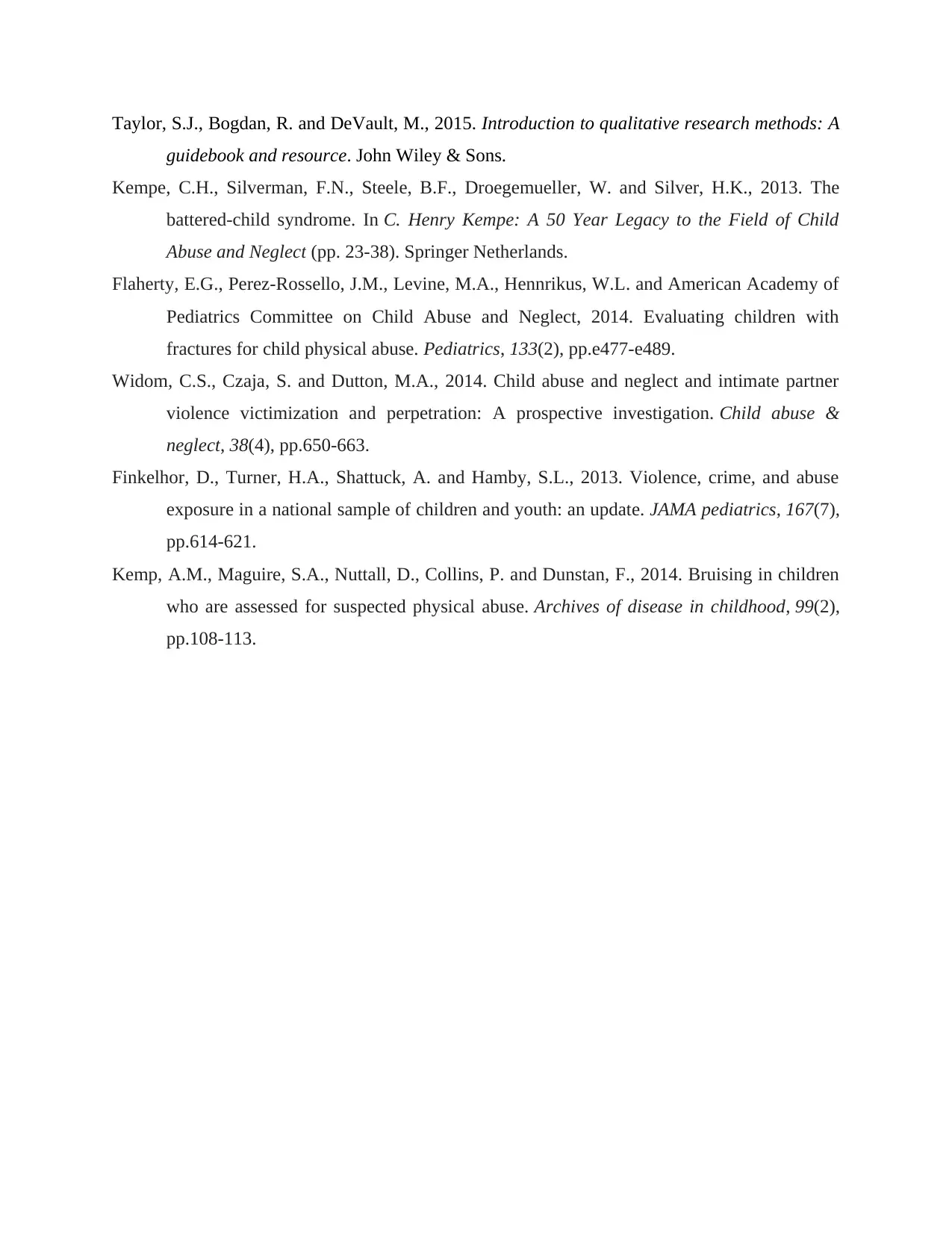
Taylor, S.J., Bogdan, R. and DeVault, M., 2015. Introduction to qualitative research methods: A
guidebook and resource. John Wiley & Sons.
Kempe, C.H., Silverman, F.N., Steele, B.F., Droegemueller, W. and Silver, H.K., 2013. The
battered-child syndrome. In C. Henry Kempe: A 50 Year Legacy to the Field of Child
Abuse and Neglect (pp. 23-38). Springer Netherlands.
Flaherty, E.G., Perez-Rossello, J.M., Levine, M.A., Hennrikus, W.L. and American Academy of
Pediatrics Committee on Child Abuse and Neglect, 2014. Evaluating children with
fractures for child physical abuse. Pediatrics, 133(2), pp.e477-e489.
Widom, C.S., Czaja, S. and Dutton, M.A., 2014. Child abuse and neglect and intimate partner
violence victimization and perpetration: A prospective investigation. Child abuse &
neglect, 38(4), pp.650-663.
Finkelhor, D., Turner, H.A., Shattuck, A. and Hamby, S.L., 2013. Violence, crime, and abuse
exposure in a national sample of children and youth: an update. JAMA pediatrics, 167(7),
pp.614-621.
Kemp, A.M., Maguire, S.A., Nuttall, D., Collins, P. and Dunstan, F., 2014. Bruising in children
who are assessed for suspected physical abuse. Archives of disease in childhood, 99(2),
pp.108-113.
guidebook and resource. John Wiley & Sons.
Kempe, C.H., Silverman, F.N., Steele, B.F., Droegemueller, W. and Silver, H.K., 2013. The
battered-child syndrome. In C. Henry Kempe: A 50 Year Legacy to the Field of Child
Abuse and Neglect (pp. 23-38). Springer Netherlands.
Flaherty, E.G., Perez-Rossello, J.M., Levine, M.A., Hennrikus, W.L. and American Academy of
Pediatrics Committee on Child Abuse and Neglect, 2014. Evaluating children with
fractures for child physical abuse. Pediatrics, 133(2), pp.e477-e489.
Widom, C.S., Czaja, S. and Dutton, M.A., 2014. Child abuse and neglect and intimate partner
violence victimization and perpetration: A prospective investigation. Child abuse &
neglect, 38(4), pp.650-663.
Finkelhor, D., Turner, H.A., Shattuck, A. and Hamby, S.L., 2013. Violence, crime, and abuse
exposure in a national sample of children and youth: an update. JAMA pediatrics, 167(7),
pp.614-621.
Kemp, A.M., Maguire, S.A., Nuttall, D., Collins, P. and Dunstan, F., 2014. Bruising in children
who are assessed for suspected physical abuse. Archives of disease in childhood, 99(2),
pp.108-113.
1 out of 11
Your All-in-One AI-Powered Toolkit for Academic Success.
+13062052269
info@desklib.com
Available 24*7 on WhatsApp / Email
![[object Object]](/_next/static/media/star-bottom.7253800d.svg)
Unlock your academic potential
© 2024 | Zucol Services PVT LTD | All rights reserved.





